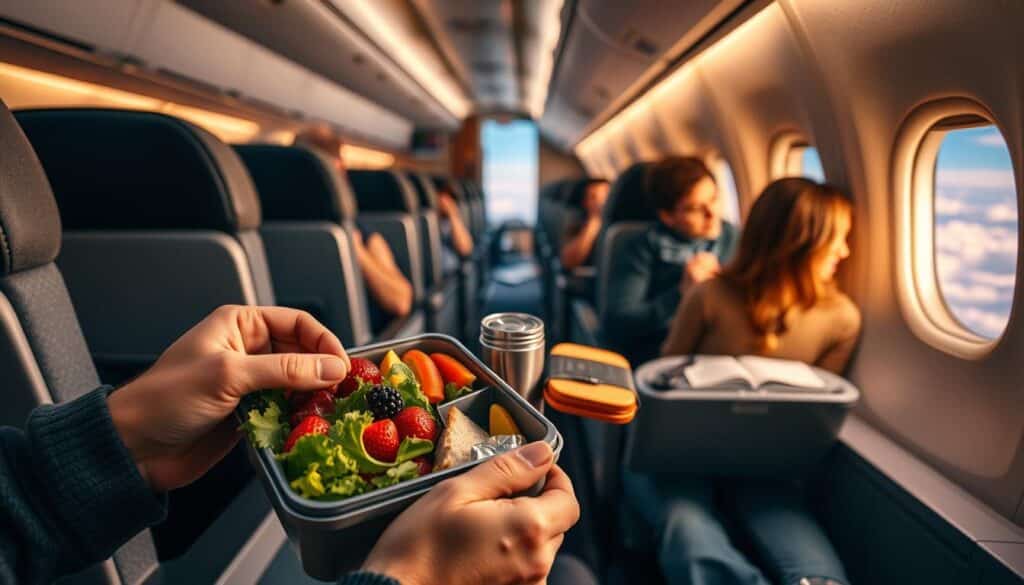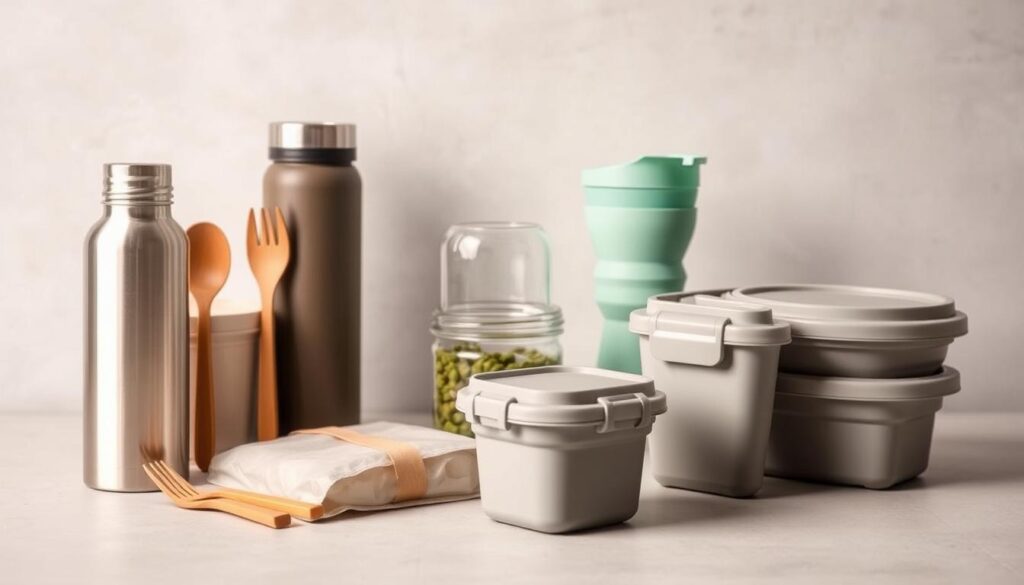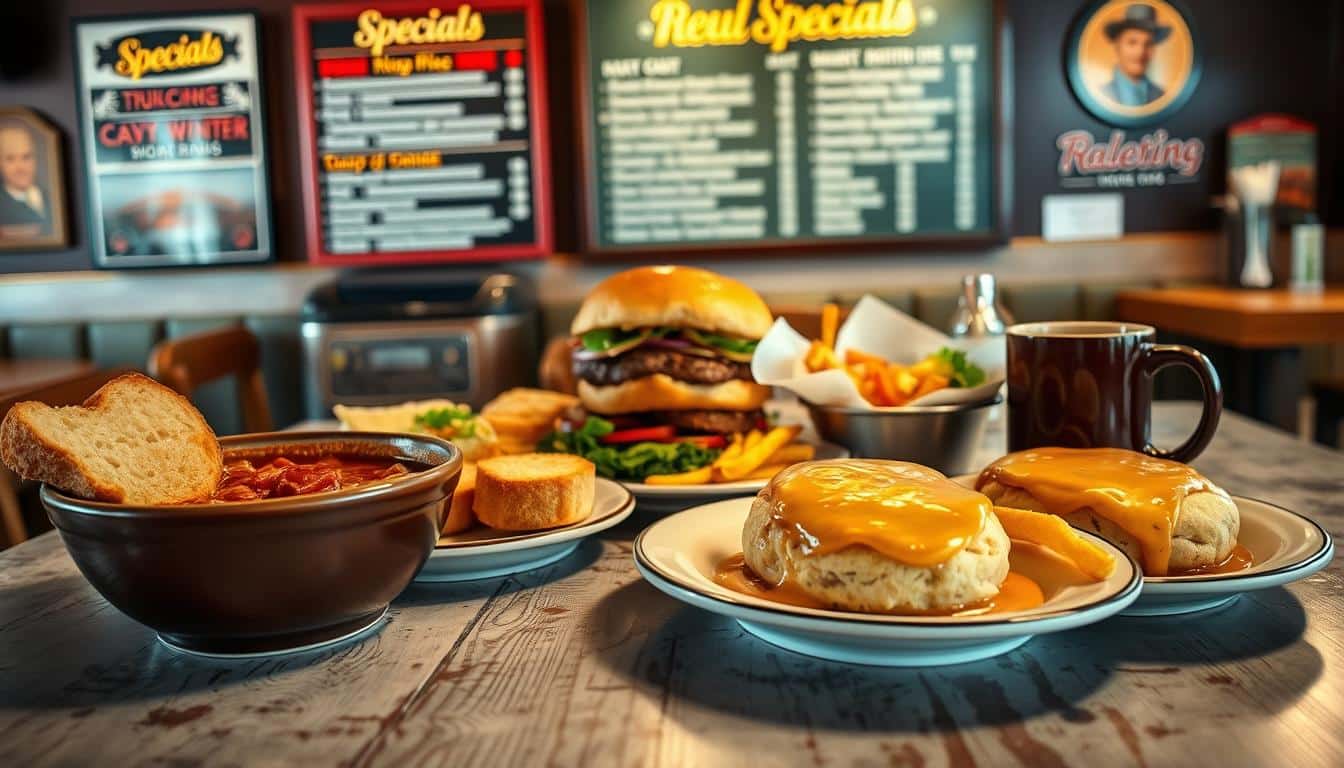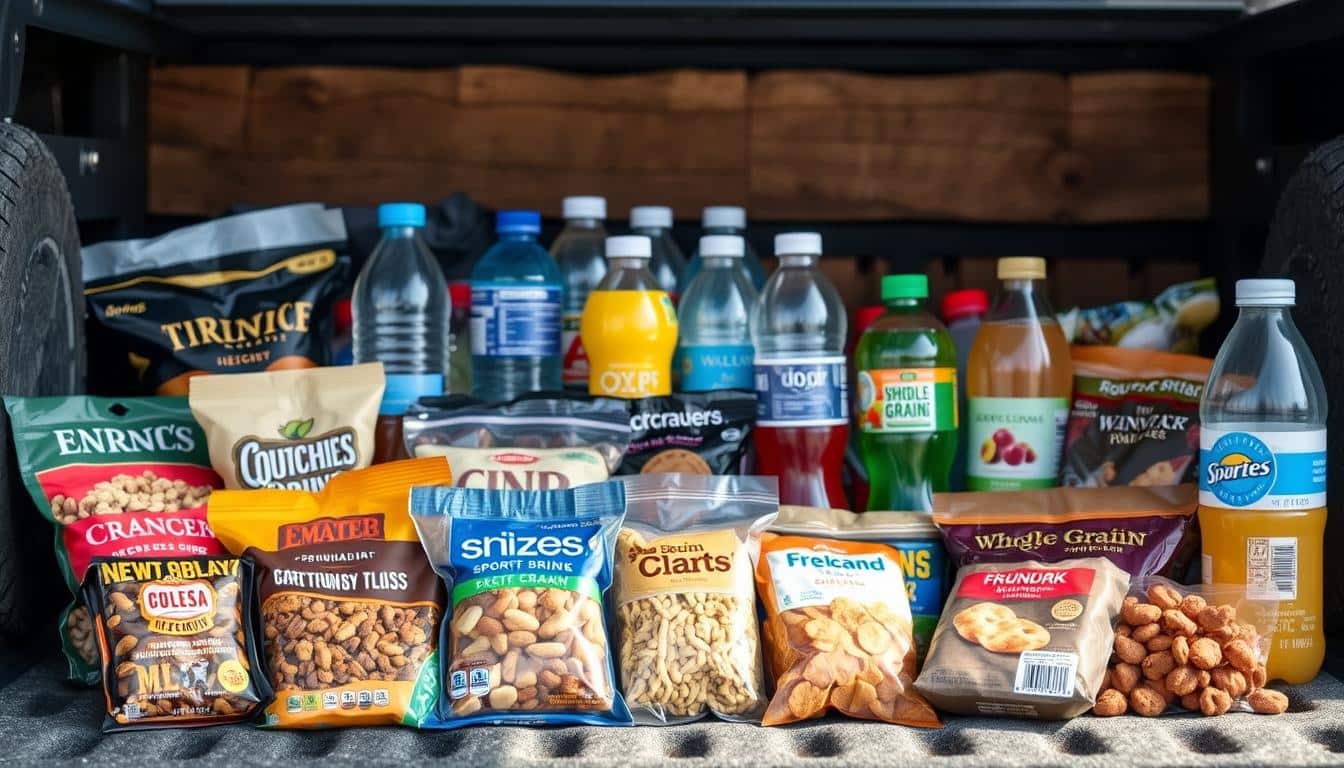When you’re on long drives, night shifts, or flights, you need good food choices. It’s important to have meals that are simple and can go anywhere with you. Choose snacks that are easy to eat on the move and don’t need to be warmed up.
Begin by buying small amounts of food and mix fresh and shelf-stable items. You can bring along fruit parfaits, overnight oats, jerky, hummus with chips, and energy balls. These meals are great for trips and help you stay away from unhealthy airport food.
Don’t forget to drink lots of water and eat different types of foods. Make sure you have proteins, carbs, fruits, veggies, and greens every day. Packing your food in insulated bags and containers helps keep it fresh. Planning your meals carefully can make your trip much easier.
Why planning matters for long hauls: nutrition, variety, and freshness
Planning meals for your trip helps keep your energy constant. It also cuts down on unplanned stops. This is key for getting enough protein, grains, fruits, and veggies every day. Making small decisions before you leave means less fast food or snacks from vending machines.
Balance macros for energy and recovery
Balance your macros by mixing lean proteins with complex carbs and some healthy fats. This combo keeps your focus sharp and helps your body recover after a long day or workout. By dividing meals into set portions, you avoid the highs and lows in energy on long drives.
- Pack grilled chicken, canned tuna, or Greek yogurt for protein.
- Choose brown rice, whole-grain wraps, or oats for slow carbs.
- Add nuts or avocado for healthy fats that reduce hunger between stops.
Variety to prevent food fatigue
Change up the textures and flavors to avoid getting tired of your food. Mix sweet and salty, crunchy and soft, to keep eating fun. Planning different meals and snacks ensures you won’t get bored, even on long trips.
- Alternate fruit, raw veggies, and pickled options.
- Swap sandwiches for grain bowls or burrito-style wraps.
- Include a small treat like dark chocolate to keep morale high.
Freshness and digestion on the road
Fresh foods are best for keeping your digestion smooth while traveling. Foods like yogurt or sauerkraut are great for your gut health. Choose low-sodium options to prevent bloating when flying or driving.
Store dressings separately and choose snacks like cucumbers, oranges, and grapes to stay hydrated. Plan your meals carefully during long duty days or shifts. This ensures you avoid energy dips and always have nutritious options ready.
Convenient meal solutions for long hauls
Good planning makes long travel days easier. Packable breakfasts, portable lunches, travel dinner ideas, and portable protein help a lot. They fit in coolers, are easy to make, and don’t need much cooking.
Packable breakfasts for early starts
Buy ripe and underripe fruit to keep them fresh longer. Bananas, apples, oranges, avocados, and peaches are great choices. Berries and grapes are yummy but should be kept cool.
Fruit parfaits with granola and dairy-free probiotic yogurt are a good start. Add chia seeds and nuts for crunch and health benefits.
Overnight oats or oatmeal jars are easy to carry. Mix oats with dried fruit, nuts, and maple syrup for a quick breakfast.
Protein shakes or smoothies are good if you have a travel blender. Mix protein powder, greens, nut butter, and frozen fruit in sealed bottles.
Hearty portable lunches and dinners
Pasta salads with pesto or olive oil last well in containers. Include roasted veggies and a protein to make it filling.
Stir-fries with tofu and quick-cook veggies reheat easily. Hearty soups like miso or pho are perfect for reheating on the go.
Tacos, burritos, and potatoes are easy to eat with your hands. Keep tortillas on the side and put them together later to stay fresh.
Quinoa or rice bowls with greens and sauce are simple and energizing. Keep ingredients separate so you can warm them up easily.
Portable protein options
Jerky and canned or vacuum-packed fish are light and don’t spoil easily. They’re convenient sources of protein.
Nut butters and energy balls are great for snacking. Energy balls are made with dates, oats, nut butter, and seeds.
Dehydrated chickpeas or edamame are good for plant-based protein. Cheese and cured meats work well for a chilled snack pack.
Avoid peanut items on planes and pick foods easy to eat in shared areas. These protein choices help you feel good and energized during long trips.
Smart snack choices to stay fueled and hydrated
Short trips and long hauls need snacks that maintain your energy and keep you hydrated. It’s best to bring a variety of snacks. This includes fresh fruits, items that last long, and savory treats. Here are some easy-to-pack options for any travel situation.
High-water-content options
- Apples, oranges, and bananas are great for travel. They offer natural hydration and a quick energy boost.
- Cucumber slices, cherry tomatoes, and celery can help you stay hydrated. They also aid digestion between meals.
- Watermelon or pre-cut melon can be great if you can keep them cool. They’re among the best snacks for staying hydrated.
Long-lasting, compact choices
- Dried fruits like apricots, dates, and apple chips are sweet and space-saving. These snacks can withstand warmth and are perfect for any journey.
- For energy and healthy fats, consider mixed nuts, seeds, and homemade granola bars. You can buy these in bulk from stores to save on packaging.
- Popcorn, coconut chips, and energy balls are light and don’t require refrigeration. They can easily fit into tight spots.
Gut-friendly and savory options
- Fermented foods like sauerkraut or kimchi are good for your gut. Pick glass jars for these to stay fresh and be easily resealed.
- Bringing hummus in a travel container, alongside crackers or veggies, makes a nourishing snack. Choose bigger containers to lessen waste.
- Pickles, olives, jerky, and other savory treats add fun to your snack mix. Just remember to consider allergies and avoid strong smells on planes.
Packing and storage strategies for meals on the move
Good packing ensures your food stays safe, fresh, and easy to grab. Create a simple system to get to breakfast or snacks quickly. Think about how much food you’ll need, cool items ahead, and pick the right containers for your travel needs.
Choosing the correct cooler size or insulated bag is key for your journey. Use small, soft coolers for short trips and hard coolers for longer stays. Start with pre-frozen bottles or gel packs to keep things cool. Keep delicate food cold and top up ice or packs during breaks.
Reusable containers and eco considerations
Opt for glass or stainless steel for lasting use and to avoid plastic. These choices are better for the planet. They also don’t hold odors. Get bulk items to cut down on packaging, and portion out big containers into smaller ones to reduce waste.
Organizing for quick access
- Use different sections for each meal type to make finding food easier.
- Mark or take pictures of bulk goods to track them.
- Bring utensils and travel-friendly cutlery for each part of your journey.
- Choose containers that compress and seal well to save space and avoid leaks.
Remember the 100 ml rule for liquids on flights and use small gel packs. Insulated bags are great for keeping food cold at the airport. Planning carefully means you can manage your meals smoothly without extra hassle.
On-the-go cooking options and quick warm meals
Short stops can make cold snacks into tasty warm meals. With compact gear and easy plans, hot food becomes simple to enjoy. Pick straightforward recipes, use dependable gear, and prep meals ahead to save both time and waste.
For car camping, choose a compact Coleman-style propane stove or a single-burner butane unit. These camp stoves usually work with propane canisters. Set it up on level ground away from your car, have a windscreen, and make sure the area is well-ventilated. Keep the fuel standing upright in a cool place and always follow the manufacturer’s safety advice.
Portable stoves and safe cooking setups
Put the stove on a sturdy table or packed gravel. Have a fire extinguisher or water bucket ready for safety. When cooking, use tools with long handles and wear gloves to protect from heat. Try your cooking setup at home to figure out what you’ll need for packing and fuel.
Simple warm meal ideas
- Pasta with pesto, Alfredo, or tomato sauce cooked in one pot for easy cleaning.
- Stir-fries with tofu, beans, mushrooms, and veggies that cook quickly.
- Tacos or burritos heated on a griddle, with pre-seasoned fillings and quick pickles.
- Soups like miso, pho, or chunky veggie stews from dried mixes for quick warmth.
- Stuffed baked potatoes roasted on coals or in a Dutch oven for a filling meal.
- Ramen boosted with fresh greens and an egg for a quick, hearty dish.
Meal-prep shortcuts
Cook grains like rice or quinoa in advance and store them in glass or stainless containers. Prep chicken, tempeh, or veggies so they’re quick to reheat. Flavoring is faster with pre-made spice mixes, like taco seasoning.
Bring along dried soups and dehydrated veggies that just need hot water from your kettle. Insulated jars keep meals like power bowls hot for hours. Using reusable containers helps cut down on waste and makes meal-prep both practical and eco-friendly.
When cooking while traveling, balance safety with convenience. Keep foods that spoil easily cold, clearly date your containers, and use up your stored food. Smart, small choices lead to more delicious hot meals and less stress during your journey.
Bringing food on flights and navigating restrictions
Planning what food to bring on a flight is important. You should know what’s allowed through security and what customs might take away. It’s also key to think about not bothering people sitting near you. There are easy ways to make sure your snacks are clean and good for traveling.

TSA and international entry considerations
- Before you pack, look up what the TSA allows for food. Remember, no liquids or gels over 100 ml (3.4 oz) in your carry-on. That means no soups, smoothies, or big portions of dips.
- Usually, you can bring small cold gel packs if they’re within the liquid rule. If something’s frozen and stays that way at screening, it might be okay. Just be ready to show these items.
- Find out what the rules are for meats, dairy, fruits, and honey where you’re going. In many places, you’ll have to declare them or throw them away at customs.
Airline etiquette and odor control
- Choose foods that won’t bother others with strong smells. Leave behind tuna and smelly cheeses for long trips.
- Be mindful of allergies. Stay away from peanuts and try to label your food with what’s inside when you can.
- Go for foods that are easy to eat in small spaces and don’t need knives. Bring travel-friendly cutlery or use what the airline provides.
Packable in-flight meal ideas
- Bring vegetables with a small amount of dip, or hummus in a travel-size container.
- Try pre-sliced cheese and cured meats on crackers, or a small charcuterie board.
- For a quick snack, pack granola bars, trail mix, popcorn, and coconut chips.
- Apple slices, grapes, and blueberries are great fruits for traveling.
- Bring light couscous or quinoa salads, just use a little dressing to keep them fresh.
- Pack dehydrated soup packets that you can add hot water to on the plane.
- Muffins, banana bread, and sandwiches with spreads that aren’t too wet are good choices.
- Keep green smoothie shots or concentrated blends under the liquid limit.
Keep your food in clear containers and a small cooler for easy security checks. Label foods that can go bad and be prepared to throw away anything if customs requires it. Making smart food choices keeps airplane meals simple, within the rules, and nice for everyone.
Meal ideas for special situations: duty days, multi-day trips, and family travel
Duty days, overnight shifts, multi-day outings, and family vacations all need different meal approaches. Thinking ahead helps maintain energy, reduce waste, and make eating easier when traveling. Here are easy, transportable meal suggestions for duty days, overnight shifts, travel with family, or meals for several days.
Feeding a long duty day or overnight shifts
Arrange meals and snacks to last the entire shift. For a 30-hour shift, include breakfast, lunch, dinner, snacks, and breakfast for the next day.
- Sandwiches made with whole-grain bread, turkey, and avocado keep energy up.
- Granola bars and energy balls for quick energy boosts.
- Beef or turkey jerky and shelf-stable protein shakes for extra calories.
- Pre-cut fruit and nuts mix to keep sugar levels balanced.
Family travel and kid-friendly packs
Choose small, varied, and colorful food items to keep kids happy. Pre-portioned meals help avoid messes and make it easy to eat on the go.
- Muffins, slices of banana bread, and mini bagels for breakfast.
- Snacks like cheese sticks, hummus with crackers, and apples with peanut butter.
- Handheld options like veggie sushi or salad rolls, and cold pasta salads for lunch.
- Bento-style boxes can separate food and keep meals interesting for kids.
Multi-day packing and food rotation
Plan to use perishable items first so they don’t spoil. Organize daily meals in labeled containers for easy access.
- Eat ripe fruit and fresh salads in the beginning.
- Save dried fruit, nuts, and canned meat for the later days.
- Think about bringing dehydrated or frozen meals that are easy to prepare.
- Replenish cooler items and buy bulk staples at local stores to keep meals fresh.
Shopping, sustainability, and budget tips
Shopping smart helps keep your meals fresh and green on trips. Small efforts can lead to big savings, especially when buying in bulk and choosing sustainable options. Discover habits and tools that work both in the U.S. and overseas.

Buying smart: bulk, local, and seasonal
- Shop from bulk bins at WinCo, Sprouts, and Whole Foods for staples like oats, nuts, and dried fruit. Use paper bags or jars to minimize packaging.
- When buying fruit, choose some that are ripe now and some to ripen later. This keeps them fresh longer and reduces waste.
- Opt for larger tubs of hummus or yogurt to cut down on single-use plastics. Making granola and nut milk at home saves money and packaging.
Low-waste packing and container choices
- Use glass jars and stainless steel containers for salads and brined items. They keep tastes true and reduce plastic use.
- Go for collapsible containers, reusable bags, and bento boxes to maximize space. Bring your own cutlery and airplane-approved utensils to avoid single-use plastics.
- A good insulated lunch bag and cold gel packs keep food safe on longer trips. They’re perfect for road trips or day outings.
Saving money on the road
- Make muffins, banana bread, and granola bars before your trip. Homemade snacks are cheaper and last longer than airport food.
- Refilling a reusable bottle at airport stations cuts costs and waste. It’s also an easy way to stay hydrated.
- Take pictures of bulk item codes or price labels to check out faster and avoid errors. Bulk buying saves money over time.
Following these tips means you can buy in bulk without waste, choose food that’s both sustainable and tasty, and save money with homemade meals. Investing a little in reusable containers and gear quickly pays off in savings and less waste.
Conclusion
Success in travel meals comes from simple planning and wise choices. Include both fresh and shelf-stable items in your meals. Use reusable containers and insulated coolers to keep your food safe and tasty.
Pack portable breakfasts, big lunches, and lots of snacks to avoid getting tired. A Coleman stove or a tiny propane burner can give you more food options. Pay attention to when food will go bad to save money and reduce waste.
When flying, make sure to follow TSA guidelines and skip foods with strong smells. Pick drinks and foods low in sodium to stay hydrated. Finally, buy snacks like jerky and trail mix in bulk, and eat perishables like berries and hummus early.
These practices will keep you energized and comfortable while saving money during your travels.
FAQ
What is the best overall approach to planning meals for long hauls?
How do I balance macros for long drives or overnight duty shifts?
What portable breakfasts travel well and keep me fueled?
Which hearty lunches and dinners are easiest to pack and reheat?
What are the best portable protein options?
Which snacks help with hydration and digestion while traveling?
What long-lasting compact snacks should I pack?
How can I include savory, gut-friendly options without offending fellow travelers?
How should I pack perishables for safety and freshness?
Are small cold gel packs allowed in air travel?
What reusable containers and eco choices work best on the road?
Can I cook warm meals on the road? What gear do I need?
What quick warm meal ideas are simple to make while traveling?
How do I pack for very long duty days, like 24–30 hours?
What are kid-friendly, family travel packing tips?
How do I handle TSA and international customs when bringing food?
What are polite in-flight food practices and odor considerations?
How can I save money on food while traveling without sacrificing nutrition?
How should I organize meals for multi-day trips to avoid waste?
Content created with the help of Artificial Intelligence.



